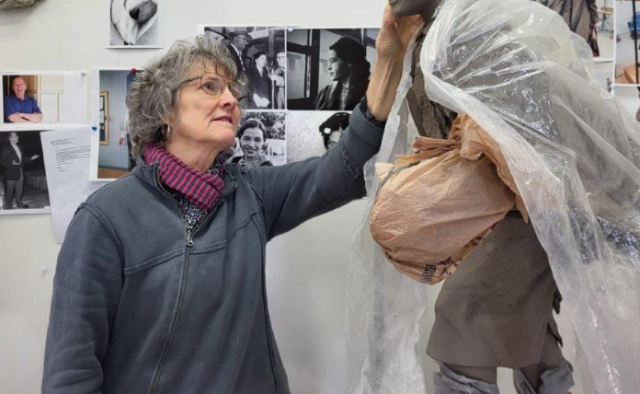
 Sculptor Julie Knight was selected to create the Rosa Parks statue for the state Capitol grounds. (contributed)
Sculptor Julie Knight was selected to create the Rosa Parks statue for the state Capitol grounds. (contributed)
By Carla Davis
Alabama News Center
When Julia Knight learned that the Alabama Women’s Tribute Statue Commission (AWTSC) was looking for an artist to sculpt a statue of Rosa Parks for the grounds of the Alabama State Capitol in Montgomery, she knew she wanted the job.
“There are already many statues of Rosa Parks sitting on a bus seat. But she is not just a tired seamstress who couldn’t get out of her seat,” said Knight. “She was in the know. She knew that the civil rights leaders of the day wanted to stand up against segregation of the Montgomery City bus system and were looking for a test case they could take all the way to the Supreme Court. I wanted to create a statue that shows an accurate picture of who Rosa Parks really is – a woman who changed the system.”
The commission approved Knight’s design for the Rosa Parks statue last May and wrapped up the fundraising stage of the project in the fall. The sculptor from Atlanta began her work earlier this year.
Parks’ refusal to give up her seat on the bus in 1955 and her subsequent arrest launched the Montgomery Bus Boycott and the modern civil rights movement. Knight’s representation of Parks will depict her with a foot raised to place on a platform, symbolizing the step leading into the bus.
 A statue of Rosa Parks is expected to rise on the Alabama Capitol grounds by the end of this year. (National Park Service)
A statue of Rosa Parks is expected to rise on the Alabama Capitol grounds by the end of this year. (National Park Service)Long before that night on the bus, Parks had been a civil rights activist and challenged racial inequality. She was secretary of the Montgomery chapter of the NAACP, a member of the Alabama Voters League and managed the office of the director of the Brotherhood of Sleeping Car Porters. In 1944, she co-founded the Committee for Equal Justice, an organization that grew to 18 chapters nationwide, with many civil rights leaders among its members.
“My premise is that Rosa Parks is not only stepping onto the bus, she’s moving forward,” Knight said. “She knew that every time she stepped onto a bus, she could be arrested for not giving up her seat. She was prepared because that’s who she was.”
Knight was selected from among 15 artists nationwide who submitted proposals for the Parks statue. Along with creating a maquette (a small model or sketch) depicting their vision of the statue, the artists took part in interviews with the commission, where they outlined their plans in detail.
“The commission took the job of selecting the artist for this project very seriously,” said Catie Marie Niolet, who, as an attorney for Birmingham-based Fortif Law Partners, provides administrative support to the commission. “They wanted an artist who had really researched Rosa Parks and knew her. Julia Knight really impressed them with her understanding of Parks and her ability to capture her in a powerful way.”
Knight is creating a 38-inch clay model that will serve as the blueprint for the project. In this way, she said she can “work out the problems,” adding that no changes can be made once she begins sculpting the final statue.
When completed, the 9-foot, 6-inch statue will be cast in bronze and will stand 17 feet in the air atop a granite base. It will face Bainbridge Street in Montgomery and hold a prominent place at the top of the Capitol steps.
Knight said the most challenging part of the project will be the physical stamina required in sculpting the massive piece.
“I have to be physically fit because I’ll be up and down ladders all day,” said Knight. “I have to keep the focus for an extended period of time.”
Knight has sculpted more than 50 commissions for public and private collections. Among her works are seven statues that make up the Polk County Sports Walk of Fame in Cedartown, Georgia. She studied at the Ringling College of Art and Design in Sarasota, Florida, and honed her skills in Pietrasanta, Italy, the town where Michelangelo and other sculptors have practiced their art for centuries.
Gov. Kay Ivey signed a law creating the AWTSC in 2019. The six-member panel, chaired by state Rep. Laura Hall, of Huntsville, was formed to commission and install statues of Parks, as well as disability and women’s rights activist Helen Keller, on the Capitol grounds. The Alabama Power Foundation has been a leading supporter of the projects.
“These women demonstrated that your status doesn’t matter if you’re committed to a cause. You’ll bring that cause to the forefront, and generally it will motivate others,” said Hall. “They were common folks and, yet, they commanded respect and demonstrated in the manner in which they approached a problem that they were truly leaders.”
Hall said the Parks statue is expected to be completed and installed by the end of this year. The commission is still raising funds for the statue of Keller, who, despite losing her hearing and sight as a toddler, never let disabilities stand in her way. A Tuscumbia, Alabama, native, Keller was a prolific writer, educator and avid supporter of human rights.
The commission has not yet selected the location of the Keller statue, Niolet said. But it will be placed in an area where it is readily accessible to – and touchable by – people with disabilities.
Knight said she is grateful to the commission for giving her the opportunity to create the statue of Parks.
“It’s such an honor and a privilege,” she said. “I’ve been given the charge of sculpting one of America’s heroes. Rosa Parks didn’t scream or shout. Not a shot was fired. All she did was not get out of her seat. In her quiet way, she changed the way things were done, and we all need to know the details of her story.”

 1 year ago
69
1 year ago
69









 English (US)
English (US)